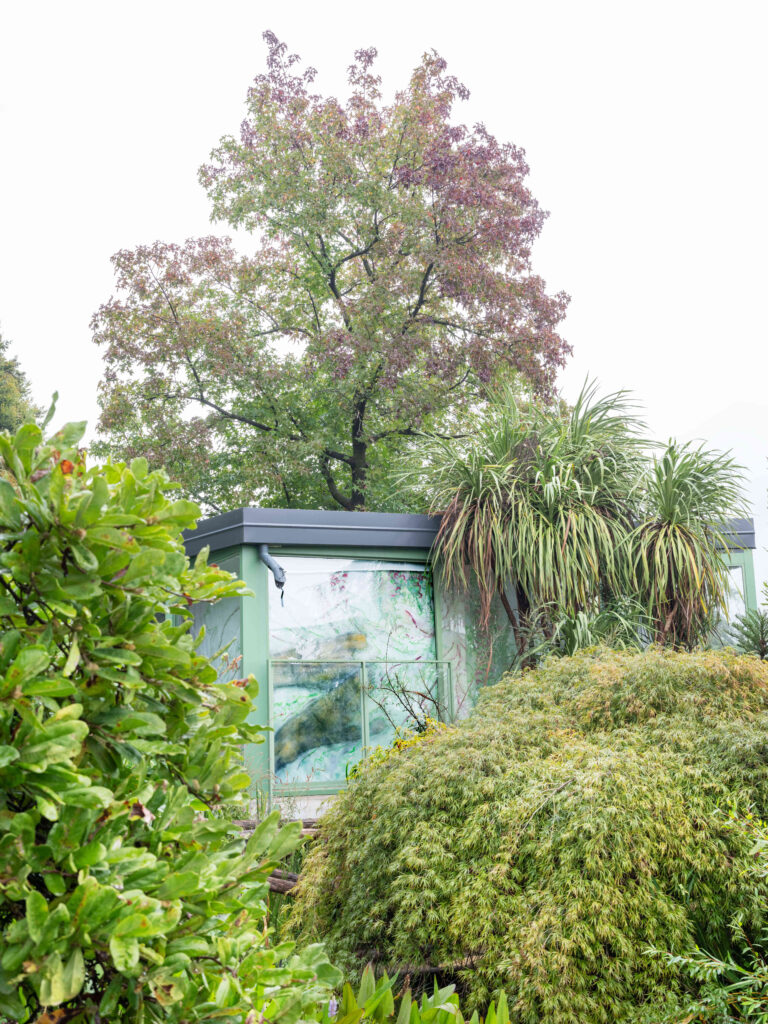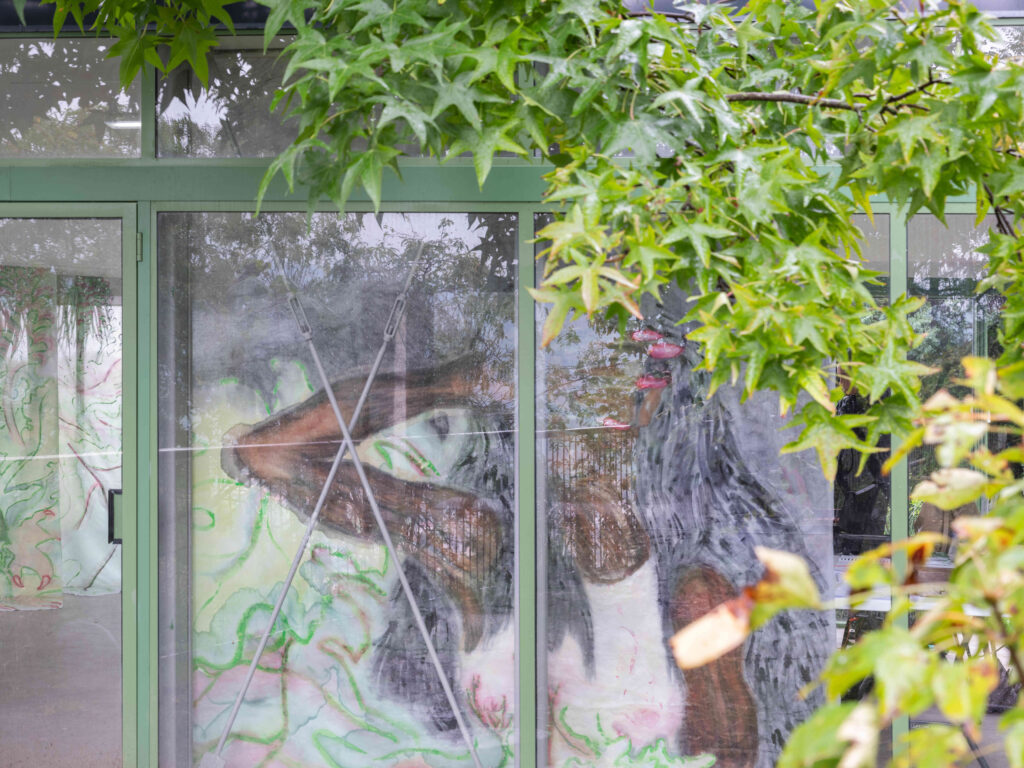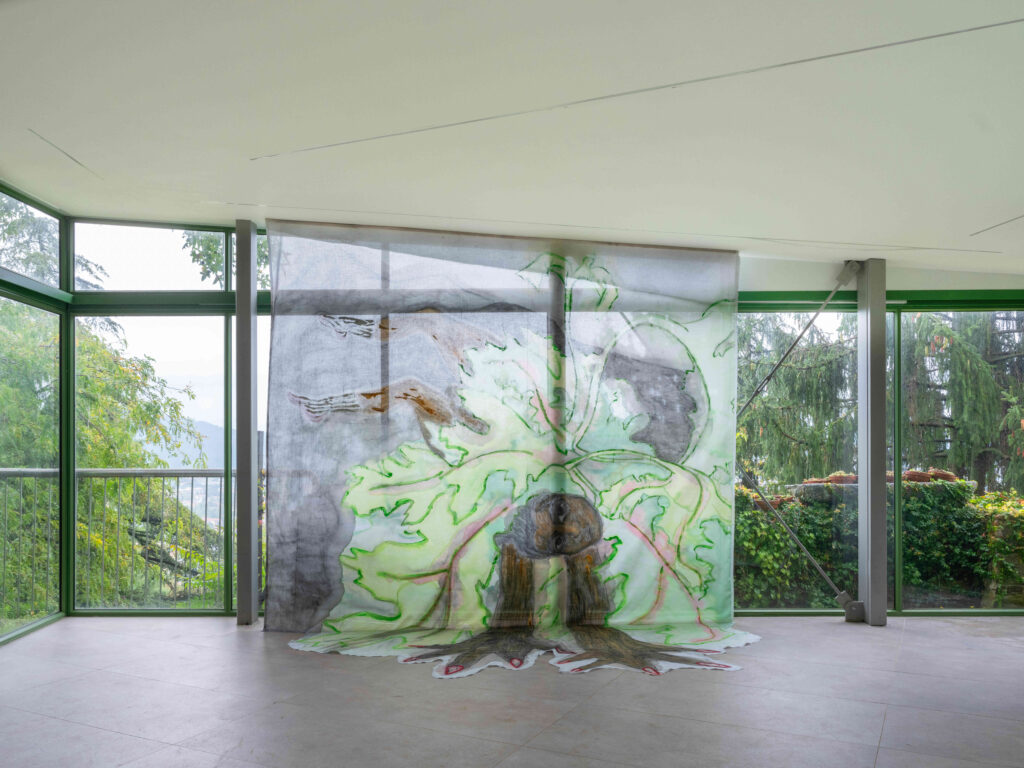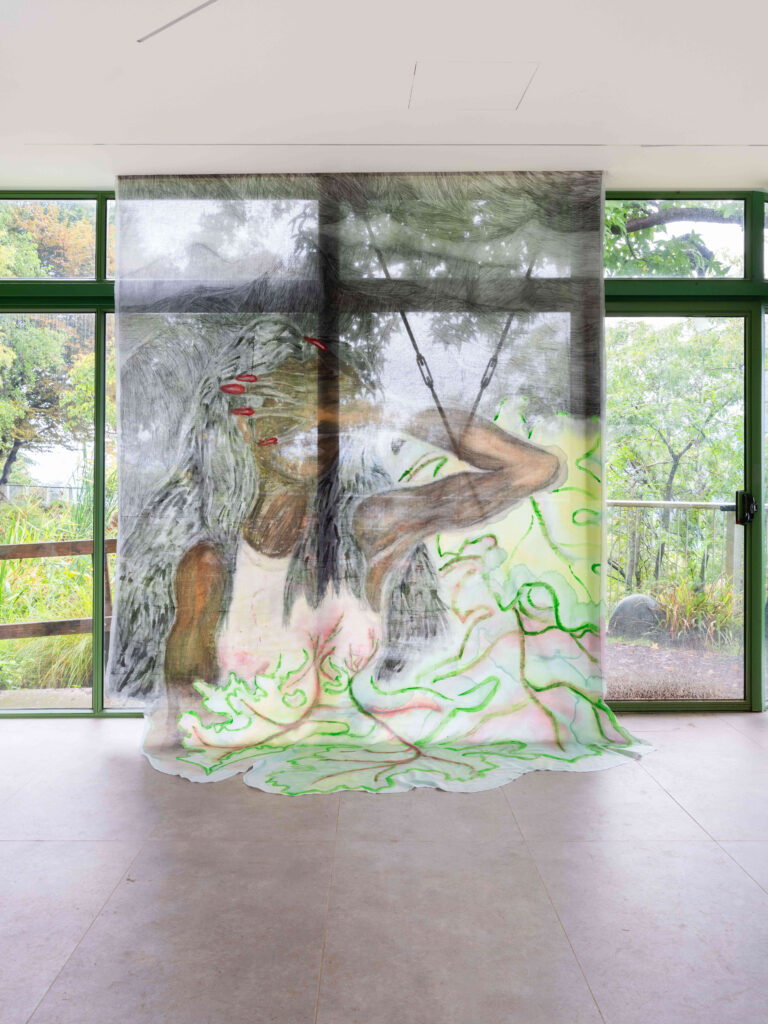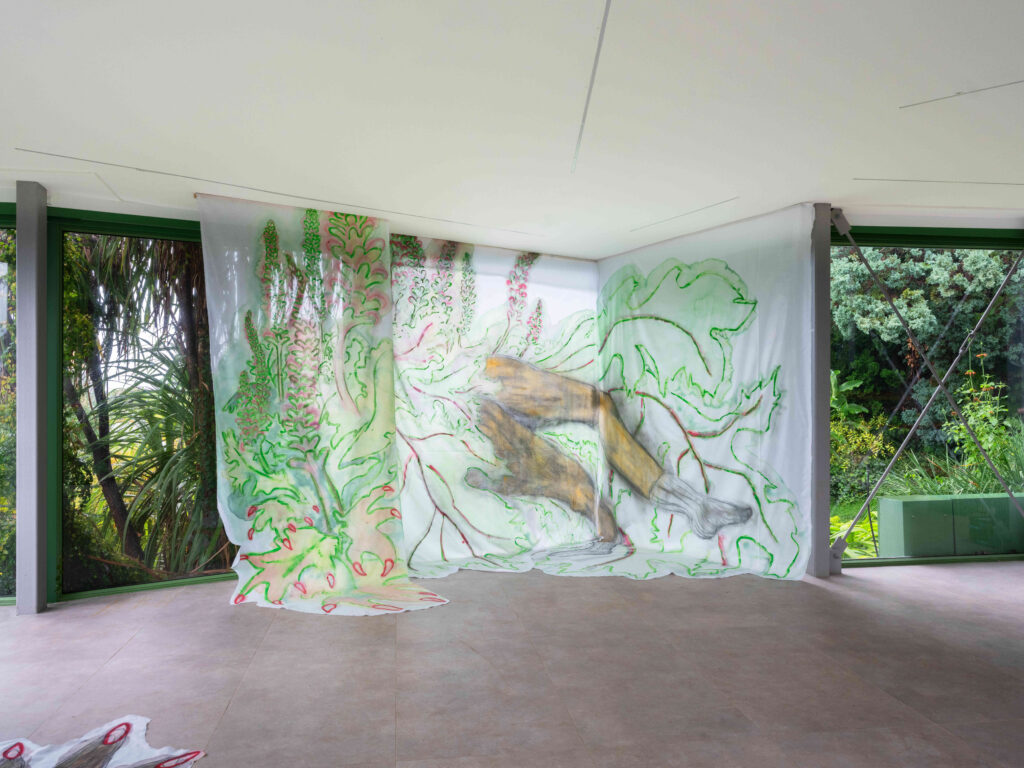If the world is a dialect called metaphor[1]
The concept of metamorphosis has always been central to Western mythological and philosophical reflection, finding particularly fertile ground in the elaboration of classical narratives that explore the relationship between the human and the nonhuman. Metamorphosis is often described as a process of loss and diminishment: the human being, as if it were the unsurpassable apex of some predetermined hierarchical order, dissolves into animal, vegetable, mineral or even celestial forms, passing a point of no return. This vision draws on a long tradition in which the female body often lies at the heart of narratives of violation and appropriation, ones where the woman is often a passive object, inscribed within a logic of visual consumption, subjected to the will of male deities and transformed for punishment, salvation, or the desires of others.
The hybrid body of Acanthus, as it emerges from Yesmine Ben Khelil’s painting, is configured as a borderland, a threshold where human and vegetable intertwine in an ongoing metamorphosis. The transformation of the nymph, prey to assault by Apollo, is marked by precise iconographic parallels: the lacquered red nails trace the deep incisions that characterize the leaves, reaching as far as the main rib, until they mutate into the thorny margins of the leaves themselves; the curly vitality of the foliage unfolds in the lobed fronds: it is precisely in the specificity of details that a process of genuine hybridization takes place, subverting the established order between what is human and what is other-than-human. This osmosis between seemingly opposite dimensions—emphasized also by the transparency of the canvas chosen by the artist, and the continuity between the inside and outside of the space of the Botanical Garden of Bergamo for which it was conceived—is part of a broader contemporary reflection on the body as a space of conflict.
Ben Khelil’s work may be linked to a broader tradition of re-reading myth from an ecofeminist perspective. In this sense, Donna Haraway offers an interesting perspective on the function of mythopoetic narrative in deconstructing nature/culture dualism and problematizing the traditional representation of nature as passive and feminized. By analyzing mythological figures such as the Gorgons, chthonic creatures lacking a stable genealogy and fixed classification, Haraway suggests they may embody a form of resistance to the binary and hierarchical logic of Western thought. These tentacular forces are not merely symbols of chaos, but active agents of transformation and resistance.
Ben Khelil’s work often uses myth to construct an augmented narrative; in this case, the transformation of Acanthus may be not just loss, but the possibility of a new form of re-inscription of the body into the world, into its remains, suspended between humanity and natural otherness, in a network of connections that escapes patriarchal and anthropocentric control.
The imagery of the uncanny, traditionally relegated to the sphere of the feminine, the monstrous, and the non-human, is re-read—both by authors such as Haraway herself or by RRosi Braidotti in Materialismo Radicale—as a space of possibility, in which the boundary between human and nonhuman becomes permeable and crossable. Initially it was the cyborg, then the Camillas, but as Haraway notes, “Cyborg writing must not be about the Fall, the imagination of a once-upon-a-time wholeness […]. Cyborg writing is about the power to survive, not on the basis of original innocence, but on the basis of seizing the tools to mark the world […]. The tools are often stories, retold stories, versions that reverse and displace the hierarchical dualisms of naturalized identities.”[2]
In Cyborg Manifesto (1985), while not treating myth and metaphor as central themes, Donna Haraway explores how the power of imagination can break down the dominant hierarchical dualism. Haraway’s post-gender figure of the cyborg, as well as that of the monster, is not simply a remnant of patriarchal and colonial violence, but becomes an active subject, capable of reknitting new intra-active connections between species, technologies, and environments.
In a scenario that foreshadows a catastrophic future, where human actions have caused severe ecological and social crises, the multispecies storytelling fostered by speculative fiction becomes a means of transition from merely acknowledging the signs of crisis (such as rising temperatures or scarcity of vital resources in the novels of Octavia Butler or Ursula K. Le Guin) to a deeper understanding of them. As Liana Borghi summarizes in her introductory text to the Italian edition of Modest_Witness@Second_Millennium. FemaleMan_Meets_OncoMouse: Feminism and Technoscience (published in Italian in 2000), “metaphors facilitate the blending of seemingly distant concepts and worlds, allowing links to be established between different dimensions and creating bold connections between time and space. Metaphors are tools that allow for the slipping and sliding of meanings, capturing subjects that would not fit into the hegemonic system of cultural reference.
“Telling stories that interweave the human and the nonhuman, that bring fiction, memory and reality into dialogue, can become a means of passing on the traces of lives erased by the violence of the Anthropocene. From this perspective, storytelling (both visual and literary) is not just an exercise in imagination, but a form of resistance, a way to create unseen connections, to reconstruct lasting connections, and to embrace the polyphony of voices and perspectives of multispeciesism.
By interweaving myth, memory, and geopolitics, Yesmine Ben Khelil manages to transform her artistic practice into an “ecological” one, a means of escaping the logics of the Anthropocene as well as imagining—and thus constructing—alternative futures, where the roots and leaves of Acanthus become symbols of multi-layered connection.
Valentina Gervasoni
[1] “Donna Haraway: se il mondo è un dialetto chiamato metafora” (If the world is a dialect called metaphor) is the title of the introduction by Liana Borghi to the Italian edition of Donna Haraway’s Modest_Witness@Second_Millennium. FemaleMan_Meets_OncoMouse: Feminism and Technoscience (Italian edition published in Milan, Feltrinelli, 2000).
[2] Donna Haraway, A Cyborg Manifesto, The Berkeley Socialist Review Collective, 1985, p. 55.
This introduction is followed by six questions posed to the artist Yesmine Ben Khelil
How would you describe the typical situation that leads to the development of your projects? What are the most recurrent stages in the elaboration of a project?
Initially, I try to immerse myself in the place and the context. It is a very broad research phase, including, for example, the space in which the work will be exhibited, the city and, more generally, the region in which the space is located (its history, its urban fabric, its geography, the activities and resources that characterize it…). It is a kind of investigation, not a scientific or rigorous one, for it involves working from memories and the state of mind I am in at that moment, although this does not always have a direct connection to the place. After collecting as many elements as possible, I weave the links; then, for some reason I cannot explain, a narrative emerges and everything seems to fall into place.
What is the potential you see in fiction as a special political language?
I think fiction allows us to convey what eludes simple representation, making us perceive the full complexity of reality, which is indeed often elusive and tends to become diluted when we try to show it directly.
In what way does the proposal you developed for Pensare come una montagna dialogue with elements of the local context?
What struck me most about Bergamo is the abundance of nature, but a nature that seems very controlled. Exhibiting in a botanical garden prompted me to reflect on this view of the nonhuman as a chaotic element that must be controlled, ordered, and conserved. This way of viewing nature has become widespread; but where I live, the lack of means to control and conserve nature creates a permanent state of conflict, where it is often perceived as a threat or an obstacle. Paradoxically, in this context where nature manifests itself just below the surface of fragile human infrastructure, it becomes easier to perceive that humans are just one element among many within the ecosystem. In Bergamo, the landscape is so well studied that it is misleading, and it is only by looking toward the mountains that we can overcome this illusion. I tried to incorporate this duality into my proposal.
What does feeling a real sense of belonging to a place mean for you?
For me, a sense of belonging is built through all the experiences that bind us to a place: memories, emotional ties, and the way the outer space shapes us internally until it becomes part of us.
Apart from communicating with the community or with individuals, how would you define a collective practice?
Although an artistic work is often perceived as an individual process and, in my case, there is something solitary about its creation, I still see it as an essentially collective practice. Viewers are involved in the exhibition just as much as in the creation stage, and a form of interdependence is created. Moreover, the work is the result of multiple influences, collaborations, exchanges and shared references that enrich the creative process.
Is there something you Apart from communicating with the community or with individuals, how would you define a collective practice?
Although an artistic work is often perceived as an individual process and, in my case, there is something solitary about its creation, I still see it as an essentially collective practice. Viewers are involved in the exhibition just as much as in the creation stage, and a form of interdependence is created. Moreover, the work is the result of multiple influences, collaborations, exchanges and shared references that enrich the creative process.




